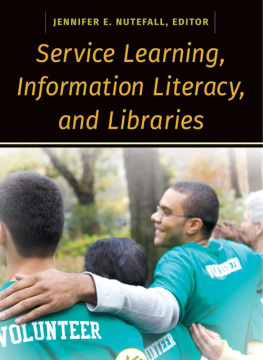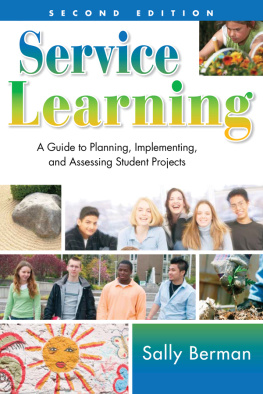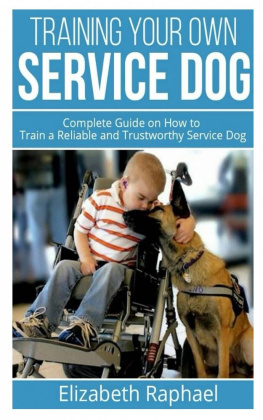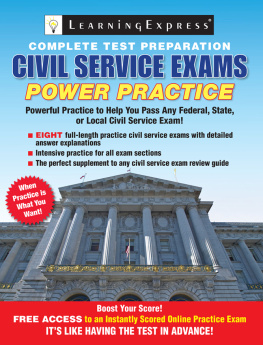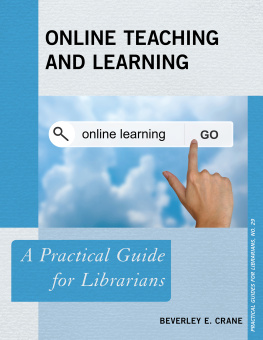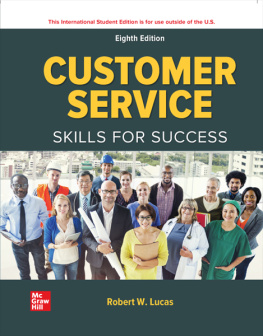

Copyright 2016 by Jennifer E. Nutefall
All rights reserved. No part of this publication may be reproduced, stored in a retrieval system, or transmitted, in any form or by any means, electronic, mechanical, photocopying, recording, or otherwise, except for the inclusion of brief quotations in a review, without prior permission in writing from the publisher.
Library of Congress Cataloging-in-Publication Data
Names: Nutefall, Jennifer, editor.
Title: Service learning, information literacy, and libraries / Jennifer E. Nutefall, editor.
Description: Santa Barbara, CA : Libraries Unlimited, an imprint of ABC-CLIO, LLC , [2016] | Includes bibliographical references and index.
Identifiers: LCCN 2015046047 (print) | LCCN 2016013159 (ebook) | ISBN 9781440840913 (paperback) | ISBN 9781440840920 (ebook)
Subjects: LCSH: Academic librariesRelations with faculty and curriculum. | Service learningStudy and teaching (Higher) | Information literacyStudy and teaching (Higher) | Libraries and colleges. | Libraries and community. | Academic librariesCase studies.
Classification: LCC Z675.U5 S44 2016 (print) | LCC Z675.U5 (ebook) | DDC 027.7dc23
LC record available at http://lccn.loc.gov/2015046047
ISBN: 978-1-4408-4091-3
EISBN: 978-1-4408-4092-0
20 19 18 17 16 1 2 3 4 5
This book is also available on the World Wide Web as an eBook.
Visit www.abc-clio.com for details.
Libraries Unlimited
An Imprint of ABC-CLIO, LLC
ABC-CLIO, LLC
130 Cremona Drive, P.O. Box 1911
Santa Barbara, California 93116-1911
This book is printed on acid-free paper 
Manufactured in the United States of America
For Phyllis Mentzell Ryder, faculty member and friend, who introduced me to service learning and continues to be an inspiration. For the women of FBC, whose support and encouragement has meant so much to me. For my friends at Santa Clara and beyond, who have listened and supported me. And to all my colleagues involved in service learning programs, may your experiences continue to inspire others as we make a difference in our institutions and communities.
Contents
Introduction
Jennifer E. Nutefall
How did you become interested in service learning? What was the first service learning course you taught or worked with? All of us have stories to tell about how we got involved in service learning and how weve seen it impact not only students but also ourselves. This book has grown from my 10-year interest and passion for service learning and my goal to continue to advance the conversation and awareness of service learning and the partnerships -librarians can build at their institutions and within the community.
My interest and involvement in service learning began in 2006. At the time I was Instruction Coordinator at George Washington University and was the librarian partner with Phyllis Mentzell Ryder (co-author of ), a faculty member in the University Writing Program. She was redesigning her first-year writing themed course Public Writing and students worked with one of six nonprofit organizations. Over the next three years, I saw the impact service learning courses have on students and found myself changed by the experience. I changed as I learned more about Washington, D.C., the needs of the communities, the focus of the nonprofit organizations, and the students experiences with the organizations and their clients. The experience activated my own interest in serving the community particularly around issues of homelessness and food insecurity. Ive carried that interest to my work as University Librarian at Santa Clara University where Ive organized several service activities for the library staff with organizations such as the Health Trust Food Basket, Estrella Family Services, and the Family Giving Tree.
My interest in service learning has expanded as it has grown from connections with individual faculty members to working at an administrative level to raise awareness both within the library and the university on the role of librarians. When talking to administrators and service learning directors, I have encountered confusion over how librarians could assist faculty and students in service learning courses and how library resources and collections could be valuable. When talking with librarians the question I most often hear is whether teaching and partnering with service learning courses is any different than any other course that incorporates research and information literacy. I firmly believe the answer is yes, and there is a small but growing body of library literature that supports this perspective.
A culminating experience, and the genesis for this book, was the design and launch of the Colloquium on Libraries and Service Learning in 2014. With the inaugural theme of Extending Our Reach, it was designed as a one-day colloquium to bring together librarians, faculty, and service learning professionals to share research, ideas, perspectives, and best practices in library engagement with/in academic service learning. We considered the colloquium a success with over 70 attendees from a wide range of backgrounds, institutions, and geographic locations. Nadinne Cruz (2014) was a powerful keynote speaker, and the many opportunities to engage and discuss during the course of the day was mentioned as one of the most important aspects by participants. Three of the chapters in the book come directly from presentations at the 2014 colloquium. With the success of the inaugural colloquium, for 2016 we are partnering with Campus Compact, as they celebrate their 30th anniversary, to offer the embedded institute Libraries and the Public Purposes of Higher Education. Our long-term goal is to hold the colloquium every other year as either a stand-alone conference or in connection with a larger service learning conference, like Campus Compact. While the librarian service learning community is currently small, it is growing, and opportunities like the colloquium are a great way to bring individuals together, spark discussion, generate new ideas, and create partnerships.
The term service learning has been used since the 1960s, and the practice has continued to gain recognition with the formation of Campus Compact in 1985 and the identification of it as a high-impact practice. Using Kuhs (2008) work, the American Association for Colleges and Universities LEAP initiative highlights service learning as a high-impact practice, which is a practice that increases student retention and engagement. In 2006, the Carnegie Foundation began offering an elective community engagement classification. In 2015, 240 U.S. colleges and universities received that classification, 83 for the first time. Professional associations are also incorporating service learning presentations at their conferences or selecting a theme closely tied to service learning. In 2013, I was a co-presenter with Maureen Barry, Sarah Twill, and Maggie Stevens on pairing information literacy and service learning at the Association of College and Research Libraries national conference. Building an engaged infrastructure was the theme for the 2015 Conference on Community Writing. And it is not just librarians and rhetoric/writing faculty presenting on service learning. The seventh annual conference for the Association for Contemplative Mind in Higher Education has a theme of building just communities. The Institute of Electrical and Electronics Engineers program Engineering Projects in Community Service hosts yearly workshops. And organizations such as the Engagement Scholarship Consortium, devoted to building university-community partnerships, host yearly conferences with themes such as Engaged scholarship: Advancing rigor, elevating impact and Engaging for change.
Next page
